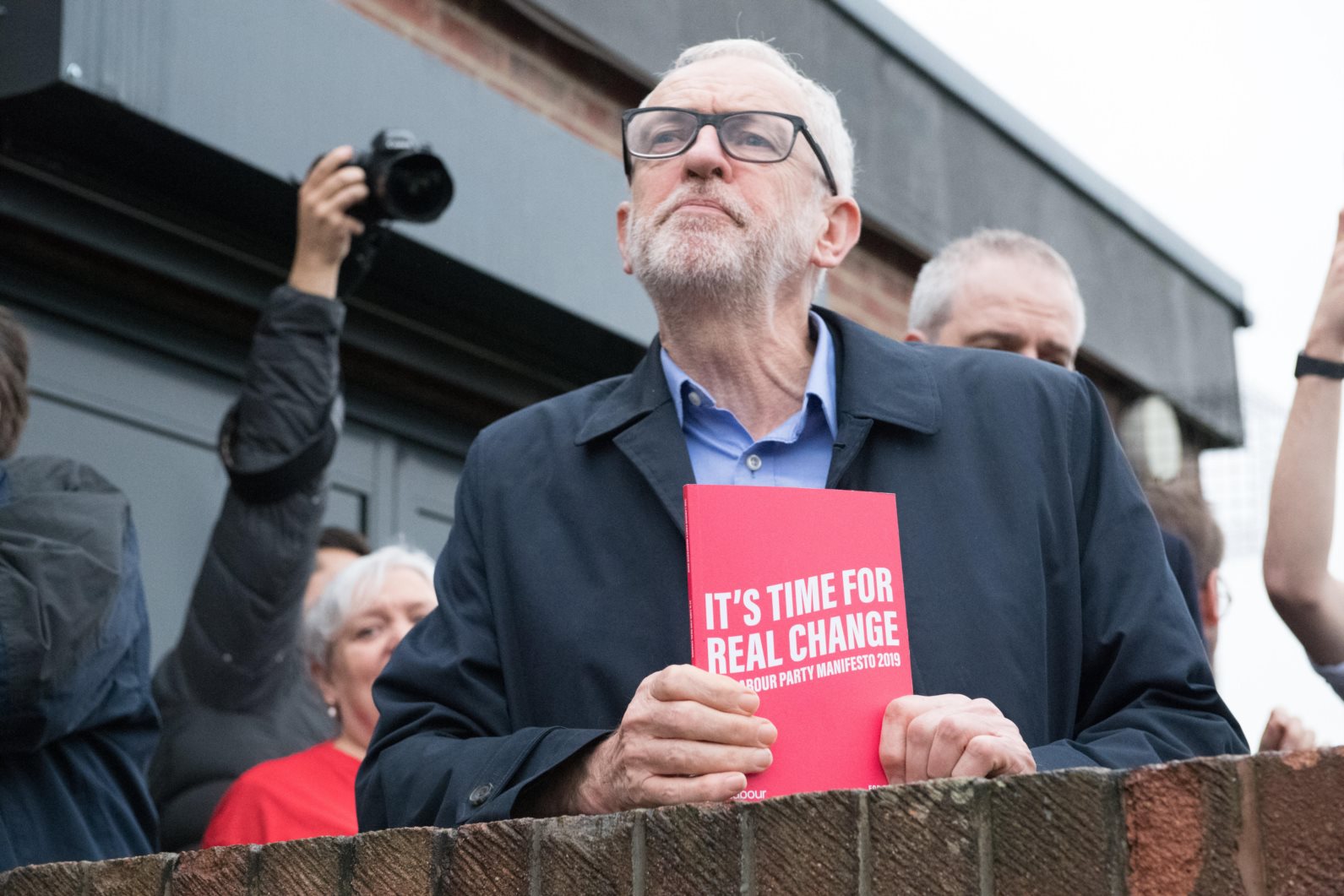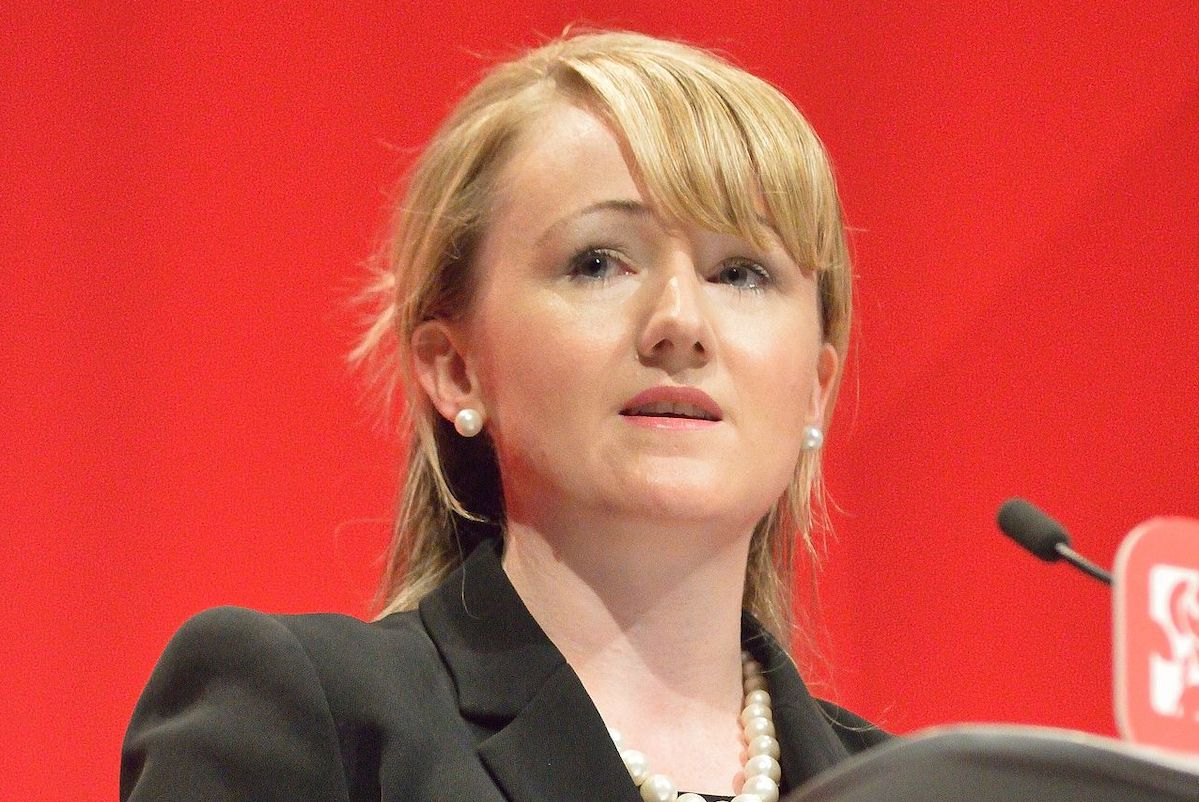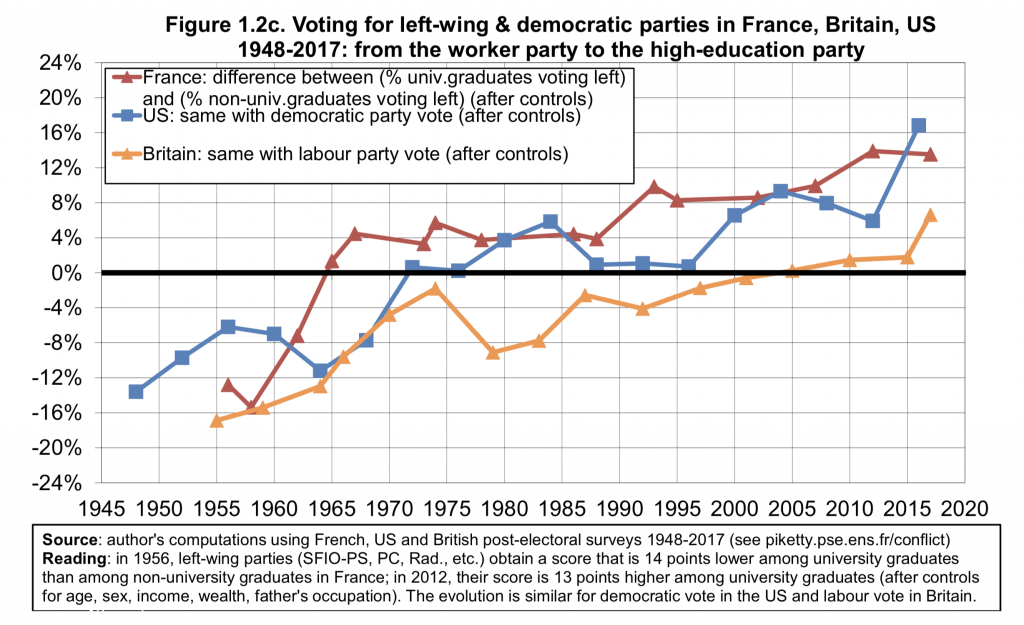British General Election 2019
Britain's Labour Party Got Woke—And Now It's Broke
Another, related phenomenon that’s been overlooked is that these “topsy turvey” politics are hardly unique to Britain. Left-of-center parties in most parts of the Anglosphere, as well as other Western democracies, have seen the equivalent of their own ‘Red Walls’ collapsing.

The Conservatives’ resounding victory in yesterday’s British General Election won’t come as a surprise to anyone who spent time canvassing in the ‘Red Wall.’ That’s the name given to a thick wedge of seats in the Midlands and North of England, some of which have been held by the Labour Party for over 75 years. Seats like Penistone and Stockbridge in Sheffield, once the home of the British steel industry, and Bishop Auckland in County Durham, a former coal town. Both turned blue in this election, as did a large number of seats in Labour’s post-industrial heartland. Not so much a ‘Red Wall’ now as a Mondrian painting made up of blue and red squares. It was the voters in those constituencies—many of them working minimum wage jobs and living in social housing—that provided Boris Johnson’s Conservatives with their highest number of seats since 1983.
Not that they have much love for the blond-haired leader. A friend of mine was standing as the Conservative candidate in Newcastle upon Tyne North, where the Labour incumbent won a 10,000 majority two years ago, and I knocked on a few doors for him last week. Every person I spoke to said they were going to vote Tory. In some cases, it was because they wanted to “get Brexit done,” which has been the Conservatives’ endlessly repeated campaign slogan over the past six weeks, but in others it was because of their visceral dislike for Labour’s leader.
“Most people I know who used to be staunch Labour are now saying no way Jeremy Corbyn,” said Steve Hurt, an engineer. “It’s not our party any more. Same label, different bottle.”
According to the activist I was with, that had been the reaction wherever he went. He had knocked on 100 doors in a council estate earlier that day and all but three people he’d spoken to told him they intended to vote Conservative—and this in a city where 26 per cent of the population are among the most deprived in England. I asked why, if these electors disliked Corbyn, they didn’t simply abstain? Why were they planning to brave the elements on a cold day in December to vote for a party led by an old Etonian toff?
“Because they hate Corbyn that much,” he said. “The biggest message they can send to him is to elect a Tory government.”

It’s the same story across England—working class electors deserting Labour en masse. We won’t have a breakdown of how people voted according to income and occupation for a while yet, but a few of the opinion polls in the run-up to election day contained some astonishing findings. For instance, a Deltapoll survey for the Mail on Sunday last month showed the Conservatives outpolling Labour by 49 per cent to 23 per cent in the C2DE social grades—the bottom half of the National Readership Survey classification system that ranks people according to their occupation. That is to say, people in the bottom half of the NRS distribution—skilled, semi-skilled and unskilled manual workers, state pensioners and people on benefits—were intending to vote Conservative rather than Labour by a ratio of more than two to one. (Exit polls suggest the actual figure was closer to 1.5 to one.)
A taste of things to come was provided on Tuesday when a clandestine recording was released of Jon Ashworth MP, Labour’s shadow health spokesman, telling a friend how “dire” things were for the party outside urban, metropolitan areas. “It’s abysmal out there,” he said. “They can’t stand Corbyn and they think Labour’s blocked Brexit.”
Ashworth described the electoral map of Britain as “topsy turvey,” a reference not just to the anticipated losses in traditional Labour areas, but to the uptick in support for Labour in middle class cities like Canterbury. One of the other startling features of the opinion polls was Labour’s lead among graduates. As a general rule, the higher the concentration of graduates in an area, the more likely it was to skew Left on Thursday—and vice versa. (Labour held on to Canterbury.)
The crumbling of the ‘Red Wall’ is the big story of this election and some commentators are describing it as a “one off.” The conventional wisdom is that working class voters have “lent” their votes to the Conservatives and, barring an upset, will give them back next time round. It’s Brexit, supposedly, that has been the game-changer—an excuse leapt on by Corbyn’s outriders in the media, who are loathe to blame Labour’s defeat on their man.
We couldn't overcome the Brexit culture war. I'm so sorry, to everyone who fought like lions til the close of polls. The movement continues, and we keep on keeping on tomorrow.
— Ash Sarkar (@AyoCaesar) December 12, 2019
If you look at the working class constituencies that turned blue, most of them voted to leave the European Union in 2016 by a significant margin—Great Grimsby, for instance, an English sea port in Yorkshire, where Leave outpolled Remain by 71.45 to 28.55 per cent. Labour’s problem, according to this analysis, is that it didn’t commit to taking Britain out of the EU during the campaign but instead said it would negotiate a new exit deal and then hold a second referendum in which the public would be able to choose between that deal and Remain. This fudge may have been enough to keep graduates on side, but it alienated working class Leave voters in England’s rust belt.
This analysis doesn’t bear much scrutiny. To begin with, the desertion of Labour by its working class supporters—and its increasing popularity with more affluent, better educated voters—is a long-term trend, not an aberration. The disappearance of Labour’s traditional base isn’t just the story of this election, but one of the main themes of Britain’s post-war political history. At its height, Labour managed to assemble a coalition of university-educated liberals in London and the South and low-income voters in Britain’s industrial heartlands in the Midlands and the North—“between Hampstead and Hull,” as the saying goes. But mass immigration and globalization have driven a wedge between Labour’s middle class and working class supporters, as has Britain’s growing welfare bill and its membership of the European Union.
At the October election in 1974, 49 per cent of skilled workers (C2) and 57 per cent of semi-skilled and unskilled workers (DE) voted Labour; by 2010, those numbers had fallen to 29 per cent and 40 per cent respectively. Among middle class voters (ABC1), support for the Conservatives fell over the same time period from 56 per cent in 1974 to 39 per cent in 2010. In 1974, Labour enjoyed a 23-point lead among skilled working class voters (C2), but by 2010 the Conservatives had overtaken them in this demo to lead by eight points—a pattern repeated in 2017. Among graduates, by contrast, Labour led by 17 points in 2017, up from a two-point lead in 2015. (See this data table compiled by Ipsos MORI, a polling company.)
Jeremy Corbyn and his supporters have talked a good deal about winning back these working class voters, but his policy positions haven’t been designed to appeal to them. I’m not just talking about his ambivalence on Brexit—there’s a widespread feeling among voters who value flag, faith and family that Corbyn isn’t one of them. Before he became Labour leader in 2015, he was an energetic protestor against nearly every armed conflict Britain has been involved in since Suez, including the Falklands War. He’s also called for the abandonment of Britain’s independent nuclear deterrent, the withdrawal of the UK from NATO and the dismantling of our security services—not to mention declining to sing the National Anthem at a Battle of Britain service in 2015. From the point of view of many working class voters, for whom love of country is still a deeply felt emotion, Corbyn seems to side with the country’s enemies more often than he does with Britain.
Corbyn’s victory in the Labour leadership election was followed by a surge in party membership— from 193,754 at the end of 2014 to 388,103 by the end of 2015. But the activists he appeals to are predominantly middle class. According to internal Party data leaked to the Guardian, a disproportionate number of them are “high status city dwellers” who own their own homes.
A careful analysis of the policies set out in Labour’s latest manifesto reveals that the main beneficiaries of the party’s proposed increase in public expenditure—which the Conservatives costed at an eye-watering £1.2 trillion—would be its middle class supporters.
For instance, the party pledged to cut rail fares by 33 per cent and pay for it by slashing the money spent on roads. But only 11 per cent of Britain’s commuters travel by train compared to 68 per cent who drive—and the former tend to be more affluent than the latter. Corbyn also promised to abolish university tuition fees at a cost of £7.2 billion per annum, a deeply regressive policy which, according to the Institute of Fiscal Studies, would benefit middle- and high-earning graduates with “very little” upside for those on low incomes.
It’s also worth noting that Corbyn’s interests and appearance—he’s a 70-year-old vegetarian with a fondness for train-drivers’ hats who has spent his life immersed in protest politics—strike many working class voters as “weird,” a word that kept coming up on the doorstep according to my fellow canvasser in Newcastle. He’s also presided over the invasion of his party by virulent anti-Semites and Labour is currently in the midst of an investigation by Britain’s Equality and Human Rights Commission thanks to his failure to deal with this. One of his supporters has already blamed the Jews for Labour’s defeat.
Who'd have guessed that Mendoza - one of the people most responsible for toxifying the British left with racially charged conspiracy theories about Jews - would blame a Jew before anyone else.
— Marlon Solomon (@supergutman) December 13, 2019
Whoever takes control of Labour, from whatever faction, please fuck these people off. pic.twitter.com/Izh8lDYgfx
But Corbyn isn’t the main reason C2DE voters have turned away from Labour, any more than Brexit is. Rather, they’ve both exacerbated a trend that’s been underway for at least 45 years, which is the fracturing of the “Hampstead and Hull” coalition and the ebbing away of Labour’s working class support.
Another, related phenomenon that’s been overlooked is that these “topsy turvey” politics are hardly unique to Britain. Left-of-center parties in most parts of the Anglosphere, as well as other Western democracies, have seen the equivalent of their own ‘Red Walls’ collapsing. One of the reasons Scott Morrison’s Liberals confounded expectations to win the Australian election last May was because Bill Shorten’s Labour Party was so unpopular in traditional working class areas like Queensland, and support for socially democratic parties outside the large cities in Scandinavia has cratered over the past 15 years or so.
Thomas Piketty, the French Marxist, wrote a paper about this phenomenon last year entitled ‘Brahmin Left vs Merchant Right: Rising Inequality and the Changing Structure of Political Conflict’ and it’s the subject of Capital and Ideology, his new book. His hypothesis is that politics in the US, Britain, and France—he confines his analysis to those three countries—is dominated by the struggle between two elite groups: the Brahmin Left and the Merchant Right. He points out that left-wing parties in the US, Britain and France used to rely on ‘nativist’ voters to win elections—low education, low income—but since the 1970s have begun to attract more and more ‘globalist’ voters—high education, high income (with the exception of the top 10 per cent of income earners). The nativists, meanwhile, have drifted to the Right, forming a coalition with the business elite. He crunches the data to show that in the US, from the 1940s to the 1960s, the more educated people were, the more likely they were to vote Republican. Now, the opposite is true, with 70% of voters with masters degrees voting for Hilary in 2016. “The trend is virtually identical in all three countries,” he writes.

In Piketty’s view, the electoral preferences of the post-industrial working class—the precariat—is a kind of false consciousness, often engendered by populist snake-charmers like Matteo Salvini and Viktor Orban. He’s intensely suspicious of the unholy alliance between super-rich “merchants” and the lumpen proletariat, and similar noises have been made about the levels of support Boris has managed to attract.
Following tonight’s devastating election results, it’s time for the left to reflect. 😞
— Titania McGrath (@TitaniaMcGrath) December 13, 2019
We have clearly failed to win over the hearts and minds of our fellow citizens.
The obvious conclusion is... we didn’t call them racist often enough. pic.twitter.com/rUbnDlvdFK
The Conservatives didn’t win in Hull or Hampstead on Thursday, but the party polled 43.6 per cent of the popular vote, which is its highest share since 1979. Labour, meanwhile, saw its seat tally fall to 203, the Party’s worst result since 1935.
Plenty of better writers than me—Douglas Murray, John Gray—have debunked the notion that the only reason low-income voters embrace right-wing politics is because they’re drunk on a cocktail of ethno-nationalism and false hope (with Rupert Murdoch and Vladimir Putin taking turns as mixologists). It surely has more to do with the Left’s sneering contempt for the “deplorables” in the flyover states as they shuttle back and forth between their walled, cosmopolitan strongholds. As Corbyn’s policy platform in Britain’s election showed, left-wing parties now have little to offer indigenous, working class people outside the big cities—and their activists often add insult to injury by describing these left-behind voters as “privileged” because they’re white or cis-gendered or whatever. So long as parties like Labour pander to their middle-class, identitarian activists and ignore the interests of the genuinely disadvantaged, they’ll continue to rack up loss after loss. Get woke, go broke.
Will the Democrats learn from Labour’s mistake and make Jo Biden the candidate—or even Pete Buttigieg? I wouldn’t bet on it. The zealots of the post-modern Left have a limitless capacity to ignore reality even when it’s staring them in the face. As I said to a friend last night after the election results starting rolling in, fighting political opponents like Jeremy Corbyn is a bit like competing in a round-the-world yacht race against a team that thinks the earth is flat. It can be kind of fun, even exhilarating. But until they acquire a compass and learn how to read a map, it’s not really a fair fight.






